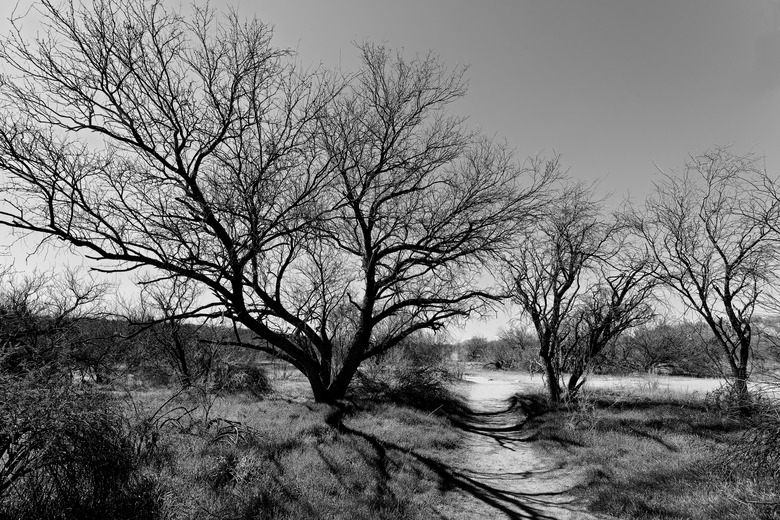How Long Does It Take To Grow A Mesquite Tree?
Mesquite trees (Prosopis spp.) grow prolifically throughout the Southwestern United States where, throughout the last century, cattle and other animals have spread mesquite seeds across the landscape. How fast these seeds and trees germinate and grow depends upon the conditions. Water, temperature and soil type greatly affect the life and growth of any tree. Mesquite trees, when provided with optimum growing conditions, can reach heights of 40 feet when fully grown (after at least 20 years) and live for more than 100 years. Mesquite trees are classified as having medium growth rates, meaning they grow 12 to 24 inches per year. Their growth rate is limited when they are faced with poor conditions.
Climate and Growing Conditions
Climate and Growing Conditions
Baby mesquite trees achieve fast-growing rates when provided with irrigation, heat and low humidity. Mesquite can survive in colder, high elevations and in deserts. For instance, the Chilean mesquite tree (Prosopis chilensis, USDA zones 8-9) tends to thrive in Arizona. However, cold weather and low water stunt the tree's growth and development. In the wild, mesquite trees are found in dry riverbeds and near water sources. Although mesquite trees thrive in riparian areas, they have also adapted to drought conditions. During severe water shortages, the tree's root system will sprout. Even as the older parts of the tree dies off, the tree continues to live through its sapling extensions. United States Forest Service employees have seen 27-year-old trees that are barely 5 feet tall due to this life-saving phenomenon.
Growth of Mesquite Trees
Growth of Mesquite Trees
Height may not always indicate the tree's rate of growth. Mesquite trees can take on one of three growth habits, depending on their growing conditions. Well-watered trees develop a single stem and attain the greatest heights, reaching up to 40 feet. Smaller trees that are faced with drought and competition from other plants send off lateral shoots which results in short, multiple-stemmed trees with a slightly shrub-like appearance. When faced with sandy soils, mesquite grows along the ground's surface, sending up runners that result in a scrub-like look.
Varieties of Mesquite Trees
Varieties of Mesquite Trees
Mesquite is indigenous to the Southwestern United States, Africa, India, South America and the Middle East. The tree's geographic spread has created a variety of species and cultivars. Planting trees native to your region ensures fast growth. Before planting, consider testing your soil's nutrients levels and texture. Plan for irrigation and ask local university extension master gardeners or nursery employees for recommendations.
Some commonly used landscape mesquite species are Texas honey mesquite (Prosopis glandulosa, zones 10-11), Thornless Honey Mesquite (P. glandulosa 'Maverick,' zones 6-10) and Black mesquite (P. nigra, zones 9-10). Hybrid varieties such as Argentinian mesquite (P. alba, zones 8-10) and Chilean mesquite (P. chilensis, zones 8-9) are considered by University of Arizona horticulturists to be among the varieties that grow the best.
Commercial Value of Thornless Mesquite
Commercial Value of Thornless Mesquite
Mesquite is often used in xeriscape, low-water landscapes, but the tree has value beyond its appearance. Commercial growers sell the tree for use in furniture making, flooring, barbecue chips and firewood. The most commonly grown commercial species is honey mesquite. When left unmanaged, the tree stand may not reach a commercially viable size. The United States Forest Service recommends thinning tree stands and actively managing the groves.
